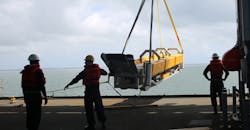Modern sea-based mines are inexpensive to construct but can inflict extremely expensive damage in terms of lives and naval equipment. For that reason, they must be detected and destroyed as effectively as possible, a top priority of the U.S. Navy. With that goal in mind, the expeditionary sea base (ESB) ship Hershel “Woody” Williams recently tested an anti-mine system in the Chesapeake Bay as part of a three-day voyage.
The ESB ship used the littoral combat ship mine countermeasure (MCM) mission package portable control station to maneuver the MCM equipment as well as launch and recovery equipment. The command and control of unmanned underwater vehicles (UUVs) was also part of the MCM operations.
By means of flexible modifications, the ESB ship could embark a dozen 20-ft. units, vehicles, and support equipment for launching, operating, and recovering one full MCM package, which includes buried mine hunting and unmanned sweeping mission modules. “Considering the contested environments which our ships sail in, counter-mine capabilities are very important because we have to be able to keep the enemy at bay,” said Captain David Gray, the USNS Hershel Woody William officer in charge.
“Mines of today are very inexpensive to make,” Gray added. “Our adversaries can produce mines for a few hundred dollars and inflict a tremendous loss of life while causing millions of dollars of damage. So we need the assets out there to detect and destroy these threats ahead of time, and keep the world’s shipping lanes open.”
The ESB platform features a large flight deck as well as generous fuel and equipment storage space to accommodate the requirements of MCM missions. It is a flexible platform that can be readily modified to incorporate the launch and control capabilities for managing MCM operations. The success of this initial demonstration provides data and insights into how to further advance the integration of subsystems on ESBs and other vessels for increasingly efficient MCM operations.
About the Author
Jack Browne
Technical Contributor
Jack Browne, Technical Contributor, has worked in technical publishing for over 30 years. He managed the content and production of three technical journals while at the American Institute of Physics, including Medical Physics and the Journal of Vacuum Science & Technology. He has been a Publisher and Editor for Penton Media, started the firm’s Wireless Symposium & Exhibition trade show in 1993, and currently serves as Technical Contributor for that company's Microwaves & RF magazine. Browne, who holds a BS in Mathematics from City College of New York and BA degrees in English and Philosophy from Fordham University, is a member of the IEEE.

